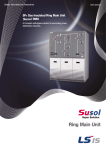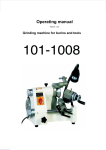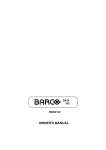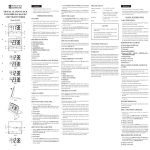Download fl2 . .2J9`?/i - Binocularsmart.com
Transcript
9. CBElJETEJIbCTHO 0 ITPPlEMKE IIpu4eJI HOYHOrO BUneHUll ((hlfirbl~~-jn)) 38B O ~ C K O HOMeP ~ ~ IIPU?AaU "OilHblM Ann 3 ~ c n n y a ~ a u u u . 99@95g-- . A . A a ~ au3rolVsneHun fl2 . .2J9'?/i - 1. GENERAL 'd 1 ' The nightfinder sight "Baigysh-SP" (hereinafter referred to as sight) complete with a sporting carbine type "Los-4"; "Los-7, "Bars" is designed to enhance the effectiveness of aiming when firing from a sporting arm and for search and observation of the higet under conditions of an ambient skylight intensity. The aiming mechanism allows for accurate varying of the sight position relalive to the weapon barrel for the sight adiustment. The range of visibility while viewing through - the sight depends o i the ambient skylight intensity, nature of the objects to be observed, transparency of atmosphere and on the contrast between the object and background. The sight is serviceable at a temperature of -10 to +3joc. Power to the sight is supplied from a 9 V d.c. source: batteries "Korund" 6PLF22, "TOSHIBA" 6F22U, 6F22K, 6F22S, "ENERGIZER", "VARTA"6F22. 3. STANDARD EQUIPMENT The nightfinder sight is a soohisti- "Bai~ysh-5P" -. cated opto-electronic unit. To ensure its proper operation, Description 1 . Nightfinder sight "Baigysh-5P" NEVER: 2 . Socket wrench -disassemble the sight by yourself; -feed the sight from power sources of over 9 V; - operate the sight ill the daytime with the objective lens open; - lay the cut-in sight on bright light sources (lights, head-lamps and the like), -apply excessive force while operating the sight. 3. Spacer -.- 1 ! I I I 4. Package 5. User Manual I Note. The sight comes on sale willlout battery. 4. SAFETY PRECAUTIONS Make sure that the sight is securely ~nountedon the arm, otherwise it may cause damage to you. 2. SPECIFICATIONS Range of acquisition of a large target (like elk) at 114 Moon night, rn, min Magnjfication Angle of field of vision Diopter setting range, dptr Time of operation from one battery "Korund" 6PLF22 at a temperature of 20" C, h, min Mass of the sight, kg, max Overall dimensions, mm, max Quantity 400 2.0" 7" Avoid excessive compression of the eyeshield when aiming. The eyeshield may be compressed until a clear margin of field of vision is obtained. 5. CONSTRUCTION &J __I 6 1.5 420x105~70 The sight consists of objective lens I (Fig. I) with the system of aiming mark displacement, body 2 with support to fix the siglit on an arm, eyepiece 4 and power supply unit 7. Body 2 houses the image converter tube and toggle switch to turn the sight onloff. Mounted on the right side of the body is knob 3 of the aiming mark brightness control. On the body of objective lens I there are two dials of the aiming mark displacement system, closed with covers 8, 9 and allowing to match the arm aiming axis and the mark in two mutually perpendicular planes. To protect optical parts against damage the objective lens and the eyepiece are closed with covers 10 and 6. Provided in the centre of cover 10 is a hole allowing observation under conditions of increased illumination (in the dusk). 6. PREPARATION FOR OPERATION 6.1. Fitting in the battery To fit in the battery, release the power unit cover by turning the cover handwheel 90" counterclockwise and remove the cover (Fig. 2). Fit in the battery observing proper polarity. Install spacer. Close the cover. Check to see that the power unit body slots match with the locking spring position. Turn the cover liandwlieel 90" clockwise; make sure that the cover is securely fixed. 6.2. Adjusting the eyepiece according to the observer's eye Check to see that the objective lens is closed with the cover. Turn on the sight by placing the switch to the "0" position (Fig. 3). viewing through the eyepiece, make sure that the screen with central aiming mark (Fig. 4) starts to illuminate. With the help of knob 3 (see Fig. 1) adjust the brightest luminescence of the aiming mark. Rotating eyepiece 4, obtain a sharp image of the object under observation. While using the sight as an ordinary observation device. to make observation more comfor!able you can switch off the aiming mark by placing the brightness col~trolk~mb3 to the extreme position. Turn off the sight. 6.3. Mountir~gthe sight on the arm Mount the sight on the arm with a fitting point of a dovetail type (carbines type "Los 4, 7") directly. For this purpose, mount the sight on the arm and securely tighten u p the screws with the wrench (Fig. 5). 6.4. Boresight zeroing on the arm For better results adjust the sight in the daytime or in the dusk. Set the arm on adjustment device without sight mounted. Aim the arm by non-optical sight at an aiming point on the target located at the distance corresponding to that of direct fire for this type of weapon. Mount the sight on the arm as directed in p. 6.3. Make sure that the objective lens is closed with the cover. ' Turn on the sight and check to see that the vertex of the aiming mark angle aligns with the same aiming point as viewed through non-optical sight. In the case the vertex of the aiming mark angle does not align with the aiming point, align them with the help of-the aiming mechanism as follows. Undo covers 8 and 9 (see Fig. 1) and making use of the dials allowing to displace the aiming mark in mutually perpendicular planes align the angle vertex with the aiming point. Remove the arm with the sight mounted on it from the adjustment device, and accurately and uniformly aiming through the sight at the aiming point, take four shots. Assess the accuracy of hits and middle point of strike. In the case the accuracy of hits is satisfactory, i.e. not worsetkan that of fire with non-optical sight for Ik-objective lens; 2-body; 3- aiming mark brightness control knob; 4--eyepiece; 5--eyeshield; 6, 10--removable protective covers; 7-power supply unit; 8, 9--covers Fig. 1 the given type of weapon, estimate the location of the middle point of strike relative to the test point (the latter may either align with the aiming point or locate over it at certain distance depeuding on type of weapon). The middle point of strike should align with the test point or deviate from it on 5' at most, this value corresponding to 15 cm for the distance of 100 m to the target or 7.5 cm for the distance of 50 m. In the case the deviation of the middle point of strike from the test point exceeds 5', it is necessary to correct the boresight zeroing with the help of the aiming mechanism following the above sequence. Take another four shots and, if necessary, fulfil additional zeroing of the sight. 7. OPERATION PROCEDURE Mount the sight onto the arm on the same fitting point as when zeroing it. While operating the sight in the daytime and in the early dusk, see that the objective lens is closed with the cover. At night and in the late dusk the objective lens should be fully open. Successful observation and shooting with the help of the sight depend on experience in observation as the picture contrast and the colouring of the terrain and the target viewed through the sight greatly differ from those observed by naked eye. To assure fatigue-free viewing and accurate fire with the sight at night, it is helpful to thoroughly investigate the locality during the daylight hours. Dark points and spots viewed in the sight field of vision originate from the image converter tube operation and are not considered to he a malfunction. 8. MAINTENANCE AND STORAGE KIJLES Keep the sight clean and protect it from sharp impacts and moisture. Remove dust from the outer optical surfaces with a dry cloth. To remove greasy spots use a cloth moistened with an alcohol or ether. The sight is to be stored in the case in a dry and heated room. I I











